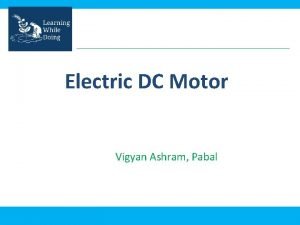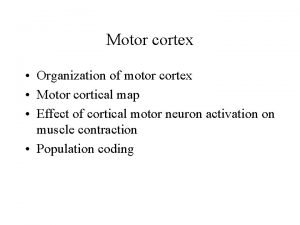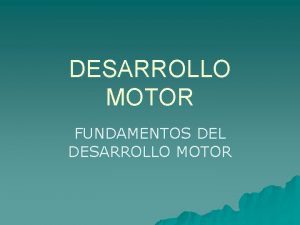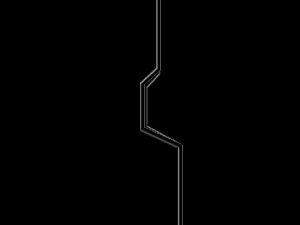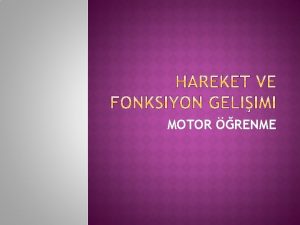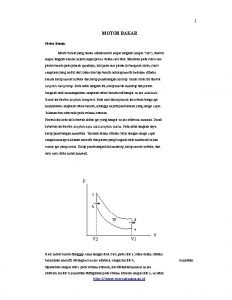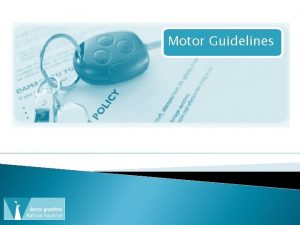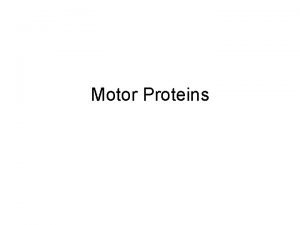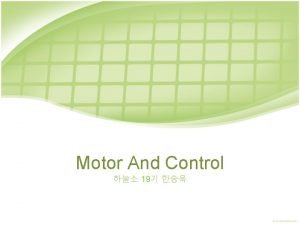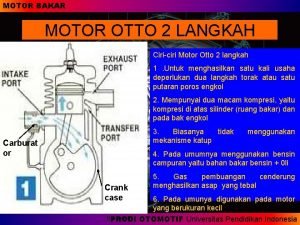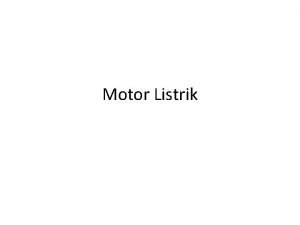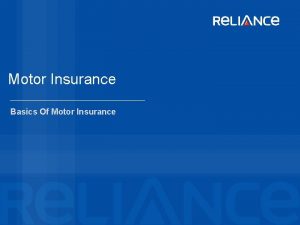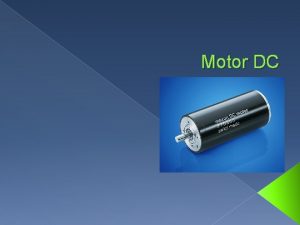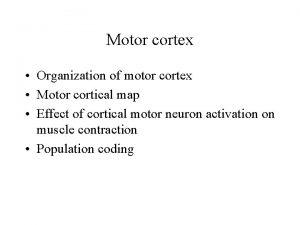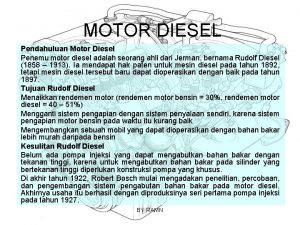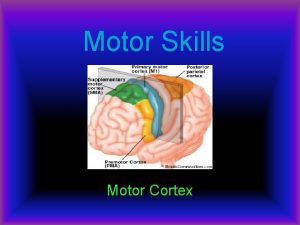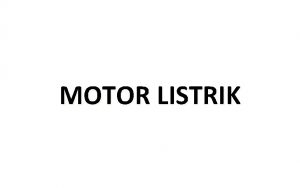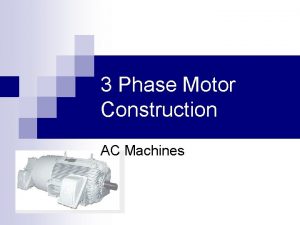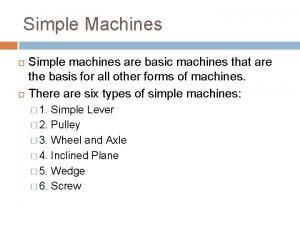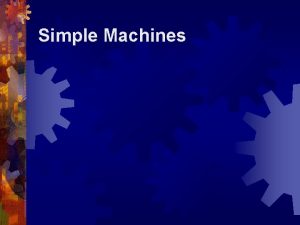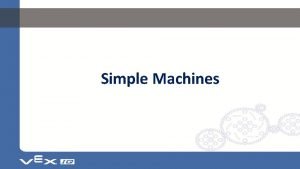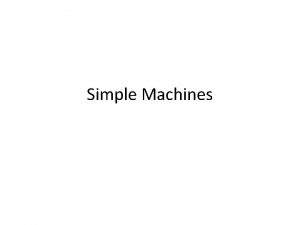DC MOTOR Introduction The Dc machines are of































- Slides: 31

DC MOTOR

Introduction • The Dc machines are of two types namely DC generators and DC motors. • A DC generators converts mechanical energy into electrical energy whereas a DC motor converts the electrical energy into mechanical energy. • In order to understand the operating principle of a DC motor, it is necessary to understand how does a current carrying conductor experience a force, when kept in a magnetic field.

Windings in DC Machine • In any dc machines, there are two windings: 1. Field winding 2. Armature winding • Out of these, the field winding is stationary which does not move at all and armature winding is mounted on a shaft. So it can rotate freely. • Connection of windings for operation as motor: Ø To operate the dc machine as a motor, the field winding and armature winding is connected across a dc power supply.

DC Motor • Principle of operation: Ø When current carrying conductor is placed in a magnetic field, it experienced a force. Ø In case of DC motor, the magnetic field us developed by the field current i. e. current flowing in field winding and armature winding plays the role of current carrying conductor Ø So armature winding experienced a force and start rotating.

Construction of DC Motor Fig. (1): construction of DC motor

• Important parts of DC motor: 1. Yoke 4. Armature 2. Field winding 5. Commutator, brushes & gear 3. poles 6. Brushes 1. Yoke: Ø It acts as the outer support of a DC motor. Ø It provides mechanical support for the poles.

2. Poles: Ø pole of a dc motor is an electromagnet. Ø The field winding is wound over the poles. Ø Poles produces magnetic flux when the filed winding is excited. 3. Field winding: Ø The coils wound around the pole are called field coils and they are connected in series with each other to form field winding. Ø When current passing through the field winding, magnetic flux produced in the air gap between pole and armature.

4. Armature: Ø Armature is a cylindrical drum mounted on shaft in which number of slots are provided. Ø Armature conductors are placed in these slots. Ø Theses armature conductors are interconnected to form the armature winding. 5. Commutator: Ø A commutator is a cylindrical drum mounted on the shaft alonwith the armature core. Ø It collects the current from the armature conductors and passed it to the external load via brushes.

6. Brushes: Ø Commutator is rotating. So it is not possible to connect the load directly to it. Ø Hence current is conducted from the armature to the external load by the carbon brushes which are held against the surface of commutator by springs.

Back EMF • When the armature winding of a dc motor starts rotating in the magnetic flux produced by the field winding, it cuts the lines of magnetic flux. • Hence according to the faraday’s laws of electromagnetic induction, there will be an induced emf in the armature winding. • As per the Lenz’s law, this induced emf acts in opposite direction to the armature supply voltage. Hence this emf is called as the back emf and denoted by Eb.

• Significance of back emf: Ø The presence of back e. m. f. makes the d. c. motor a self -regulating machine i. e. , it makes the motor to draw as much armature current as is just sufficient to develop the torque required by the load. 1. When the motor is running on no load, small torque is required to overcome the friction and windage losses. Therefore, the armature current Ia is small and the back e. m. f. is nearly equal to the applied voltage.

2. If the motor is suddenly loaded, the first effect is to cause the armature to slow down. Therefore, the speed at which the armature conductors move through the field is reduced and hence the back e. m. f. Eb falls. The decreased back e. m. f. allows a larger current to flow through the armature and larger current means increased driving torque. Thus, the driving torque increases as the motor slows down. The motor will stop slowing down when the armature current is just sufficient to produce the increased torque required by the load.

3. If the load on the motor is decreased, the driving torque is momentarily in excess of the requirement so that armature is accelerated. As the armature speed increases, the back e. m. f. Eb also increases and causes the armature current Ia to decrease. The motor will stop accelerating when the armature current is just sufficient to produce the reduced torque required by the load. It follows, therefore, that back e. m. f. in a d. c. motor regulates the flow of armature current i. e. , it automatically changes the armature current to meet the Load requirement.

Voltage Equation of a DC Motor Fig. (1): Equivalent circuit of DC motor

• As shown in fig. (1), the armature supply voltage V has to overcome the opposition posed by the back emf Eb and some other voltage drops such as brush drop and the voltage drop across Ra. • From fig. (1), we can write that, V = E b + I a R a + Vb ……. (1) • But voltage drop across brushes is negligible. ∴ V = Eb + I a R a ……(2)

Types of DC Motors • Depending on the way of connecting the armature and field windings of a d. c. motors are classified as follows: DC Motor DC series motor Shunt motor Short shunt compound Compound motor Separately excited motor Long shunt compound

DC Shunt Motor • In DC shunt type motor, field and armature winding are connected in parallel as shown in fig. (1), and this combination is connected across a common dc power supply. • The resistance of shunt field winding (Rsh) is always much higher than that of armature winding (Ra). • This is because the number of turns for the field winding is more than that of armature winding.

• The field current Ish always remains constant. Since V and Rsh both are constant. Hence flux produced also remains constant. Because field current is responsible for generation of flux. ∴ ø ∝ Ish • This is why the shunt motor is also called as the constant flux motors.

Fig. (1): DC shunt motor schematic diagram

DC Series Motor • In DC series motor, the armature and field windings are connected din series with each other as shown in fig. (1). • The resistance of the series field winding (Rs) is much smaller as compared to that of the armature resistance (Ra). • The flux produced is proportional to the field current. But in series motor, the field current is same as armature current. ∴ ø ∝ Ia or ∴ ø ∝ Is

• The armature current Ia and hence field current Is will be dependent on the load. • Hence in DC series motor the flux does not remains constant. Fig. (1): DC series motor schematic diagram

DC Compound Motor 1. Long Shunt Compound Motor: • As shown in fig. (1), in long shunt dc motor, shunt field winding is connected across the series combination of the armature and series field winding. 2. Short Shunt Compound Motor: • In short shunt compound motor, armature and field windings are connected in parallel with each other and this combination is connected din series with the series filed winding. This is shown in fig. (2). Ø The long shunt and short shunt compound motors are further classified as cumulative and differential compound motors

Fig. (1): Long shunt compound dc motor fig. (2): Short shunt compound dc motor

Torque & Speed Equations • Torque equations: Ø Torque produced by a motor will always be proportional to the air gap flux ø and the current flowing through the armature winding (Ia). Ø That means T ∝ ø Ia Ø The flux is produced by the field current hence ø will be proportional to field current. That means, ø ∝ Ifield Ø hence torque produced by a dc motor is proportional to the product of Ia and Ifield. That means, T ∝ Ia Ifield ………. . (1) Ø For various types of dc motors the expression for field current will be different. We will substitute them into eq. (1) to get the torque equations .

1. Torque equation of DC shunt motor: Ø For DC shunt motor Ifield = V/ Rsh = constant Ø Hence the flux ø is constant. ∴ T ∝ Ia ……. . (2) Ø Hence in dc shunt motor, torque is proportional to only to the armature current. 2. Torque equation DC series motor: Ø For DC series motor, the field current is equal to the armature current i. e. Ifield = Ia. Ø Hence T ∝ Ia Ia ∴ T ∝ Ia 2 ………(3) Ø Hence in dc series motor, torque is proportional to the square of armature current.

• Speed Equations: Ø We know that the expression for the back emf is, Ø But P, Z and 60 A are constants. Therefore we can write that, Eb ∝ ø N ……(4) Ø Therefore the speed can be expressed as, N ∝ Eb / ø ……. (5) N = k Eb/ ø ………(6) Ø But V = Eb + Ia Ra ∴ Eb = V - I a Ra ………. . (7) Ø Substituting eq. (7) into eq. (5) we get, N ∝ (V - Ia Ra) / ø ……. (8) Ø Since ø ∝ Ifield , we can write, N ∝ (V - Ia Ra) / Ifield ……. (9)

1. DC shunt motor: Ø For dc shunt motor, the flux ø is constant. ∴ N ∝ (V - Ia Ra) …. . (10) 2. DC series motor: Ø For dc series motor Ifield = Ia. Therefore N ∝ (V - Ia Ra - Is Rs) / Ia ……. (11) where Eb = V - Ia Ra - Is Rs

Applications of DC Motor 1. Shunt motor applications: i. Various machine tools such as lathe machines, drilling machines, milling machines etc. ii. Printing machines iii. Paper machines iv. Centrifugal and reciprocating pumps v. Blowers and fans etc.

2. Series motor applications: i. Electric trains ii. Diesel-electric locomotives iii. Cranes iv. Hoists v. Trolley cars and trolley buses vi. Rapid transit systems vii. Conveyers etc.

3. Cumulative compound motor applications: i. Elevators ii. Rolling mills iii. Planers iv. Punches v. Shears 4. Differentials compound motors applications: Ø The speed of these motors will increase with increase in the load, which leads to an unstable operation. Ø Therefore we can not use this motor for any practical applications

Specifications of DC Motor • Some of important specifications of a DC motor: 1. Output power in horse power(H. P. ) 2. Rated voltage 3. Type of field winding 4. Excitation voltage 5. Base speed in RPM 6. Current 7. Frame size 8. Rating
 Mikael ferm
Mikael ferm Pony motor starting method
Pony motor starting method One motor unit
One motor unit Principle of operation of synchronous motor
Principle of operation of synchronous motor Motor parts name
Motor parts name Ee 216
Ee 216 Introduction to simple machines
Introduction to simple machines Hình ảnh bộ gõ cơ thể búng tay
Hình ảnh bộ gõ cơ thể búng tay Bổ thể
Bổ thể Tỉ lệ cơ thể trẻ em
Tỉ lệ cơ thể trẻ em Gấu đi như thế nào
Gấu đi như thế nào Tư thế worm breton là gì
Tư thế worm breton là gì Chúa yêu trần thế alleluia
Chúa yêu trần thế alleluia Môn thể thao bắt đầu bằng từ đua
Môn thể thao bắt đầu bằng từ đua Thế nào là hệ số cao nhất
Thế nào là hệ số cao nhất Các châu lục và đại dương trên thế giới
Các châu lục và đại dương trên thế giới Công thức tính thế năng
Công thức tính thế năng Trời xanh đây là của chúng ta thể thơ
Trời xanh đây là của chúng ta thể thơ Mật thư anh em như thể tay chân
Mật thư anh em như thể tay chân Phép trừ bù
Phép trừ bù độ dài liên kết
độ dài liên kết Các châu lục và đại dương trên thế giới
Các châu lục và đại dương trên thế giới Thơ thất ngôn tứ tuyệt đường luật
Thơ thất ngôn tứ tuyệt đường luật Quá trình desamine hóa có thể tạo ra
Quá trình desamine hóa có thể tạo ra Một số thể thơ truyền thống
Một số thể thơ truyền thống Cái miệng nó xinh thế chỉ nói điều hay thôi
Cái miệng nó xinh thế chỉ nói điều hay thôi Vẽ hình chiếu vuông góc của vật thể sau
Vẽ hình chiếu vuông góc của vật thể sau Thế nào là sự mỏi cơ
Thế nào là sự mỏi cơ đặc điểm cơ thể của người tối cổ
đặc điểm cơ thể của người tối cổ Thế nào là giọng cùng tên? *
Thế nào là giọng cùng tên? * Vẽ hình chiếu đứng bằng cạnh của vật thể
Vẽ hình chiếu đứng bằng cạnh của vật thể




